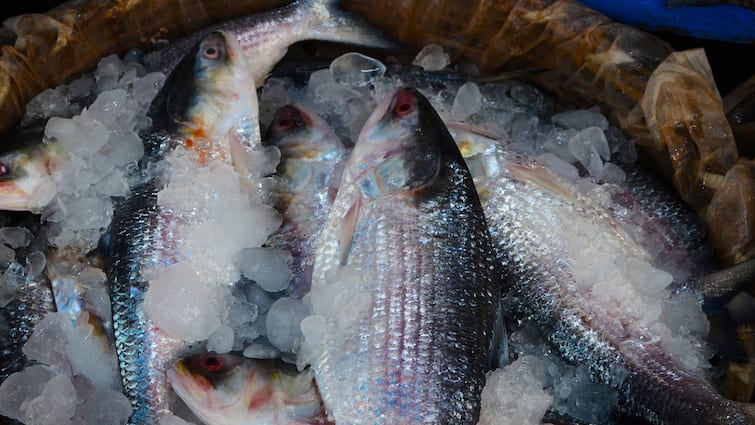Kolkata, Sep 9 (PTI) The Md Yunus government in Bangladesh may have chosen to honour the commitment of culinary tradition and issue a notification to export hilsa to India ahead of the festive season, but fish importers in West Bengal aren’t sure whether the move will broaden smiles of the average middle class waiting to savour the delight of ‘Padmar Ilish’ this Durga Puja.
Fish traders on this side of the international border attribute dual factors of lower quantity of export from Bangladesh compared to previous years, as well as higher cost of imports, as reasons behind the high prices of ‘rupali shosyo’, which means ‘silver crop’.
Putting apprehensions of an export freeze on hilsa to rest, the Bangladesh government’s notice on Monday stated that it has approved in-principle the “conditional export” of 1200 metric tonnes of hilsa to India this year, in keeping with its traditional Durga Puja gift to Bengalis in India.
For this, the Md Yunus government has invited applications from interested exporters in Bangladesh within a deadline of 5 pm on September 11. It has fixed USD 12.5 (Rs 1,100) a kilo as the base price for the fish.
“We were expecting that the Bangladesh government would permit us to import at least 3,000 metric tonnes of hilsa this year. The volume, which has been ultimately approved, is far less than what we hoped for. This would inevitably mean that ‘Padmar Ilish’ (hilsa of the Padma river) would remain costly and out of bounds for most hilsa admirers this Puja,” said Atul Chandra Das, president of the Fish Importers’ Association of Bengal.
Das expected that the prices of imported hilsa would range from Rs 1,500 to Rs 1,800 a kilo in the wholesale markets of West Bengal and would hover around Rs 2,000 to Rs 2,500 in the retail markets.
“Last year, we imported hilsa at USD 10 (Rs 880) per kg from Bangladesh. The 25 per cent hike in import costs this year would also contribute to higher hilsa prices this season,” Das maintained.
Hilsa from Bangladesh, traders confirmed, is imported to India entirely through the land borders of West Bengal and Tripura. While about 80 per cent of the total volume of imports happens through the integrated land port at Petrapole in West Bengal’s North 24 Parganas district, the rest pass through the Agartala land border, they said.
“Although the Bangladesh government has approved 1,200 metric tonnes of hilsa for export, the actual supply to this side of the border could be much less. That’s because the volume of catch in rivers on both sides has witnessed a sharp fall this season. The approved volume is only the upper limit. The exporters may not have that quantity in their possession if the catch is insufficient,” a fish trader said.
Asked whether he suspected political reasons, besides the decline in catch volume, behind the fixing of a lower export quantity from the neighbouring country, Das disagreed.
“If politics had to play a part in this, then that government would have frozen exports altogether. It’s the dearth in catch that’s contributing to low supply and high prices of hilsa this season,” he stated.
Traders maintained that the hilsa business in the local markets of Bengal and the rest of eastern India is likely to suffer a hit, and palates of the average Bengali possibly remain void of the fish’s coveted Bangladeshi variant despite the Yunus regime remaining committed to a tradition the earlier governments of that country followed.
(This report has been published as part of the auto-generated syndicate wire feed. Apart from the headline, no editing has been done in the copy by ABP Live.)



